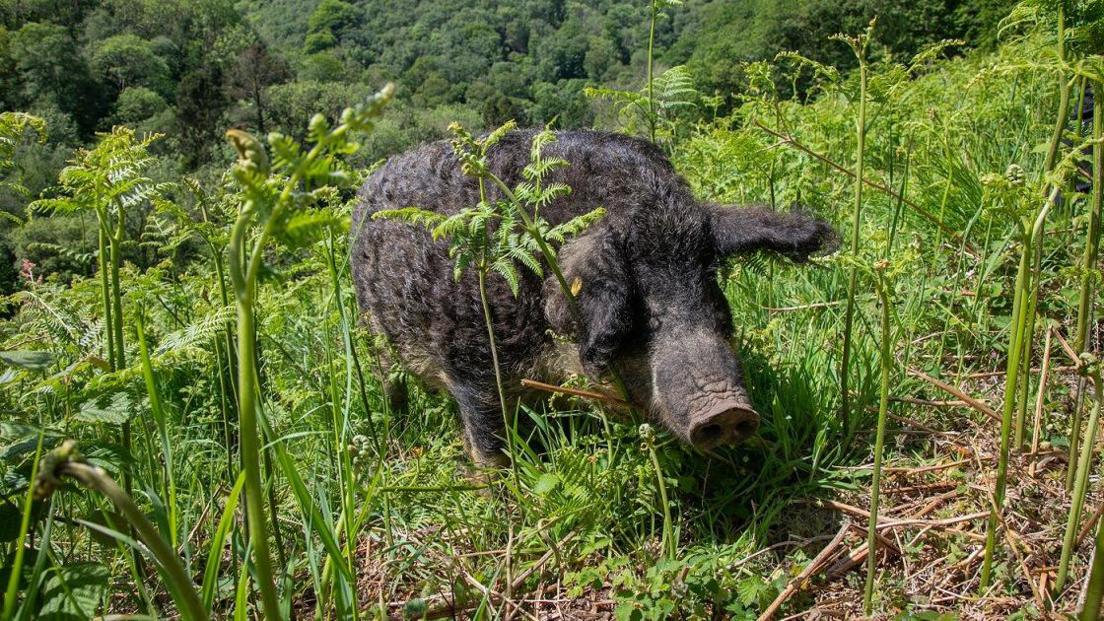How hairy hogs are helping boost butterfly numbers

The hogs are helping to create an ideal habitat for the UK鈥檚 most endangered butterfly
- Published
You've probably heard the saying 'teamwork makes the dream work', and one unlikely species is using its special skills to help out another.
Hairy Hungarian hogs, which are also known as Mangalitsa pigs, have been recruited by conservationists for a new project to create a better habitat for the UK's most endangered butterfly.
The pigs are being sent to a National Trust site on Exmoor in Devon, along with English Longhorn cattle.
Here, they'll operate as "living lawnmowers", helping to produce ideal breeding conditions for the High Brown Fritillary butterfly.
More stories like this
- Published10 June
- Published31 January 2023
- Published7 June
The butterfly, known for its bright orange colour and distinctive black marks, is one of the biggest in the UK.
The species was once widespread across England and Wales, but has seen a drastic fall in numbers since the 1960s.
This is largely because of changes to both their habitat and the way land is managed, according to nature charity Butterfly Conservation which is leading on the new project alongside the National Trust.
The High Brown Fritillary's population had fallen by 65% since the 1970s
The High Brown Fritillary's population had fallen by two thirds (65%) since 1978 with the insect found in only three locations in England, the charity said.
One of sites where the butterflies can still be found is the National Trust's Heddon Valley, near Barnstaple.
Although the habitat here offers ideal breeding conditions, Butterfly Conservation says trees and shrubs quickly take over.
So the charity is using the Hungarian breed of pigs and the cattle to graze down growing plants.
This will help create space for the common dog-violet, which is the only food plant for the insect's spiky caterpillars.
How will the project work?
English Longhorn cattle will also help graze down growing plants in the National Trust's Heddon Valley
Fencing has been put up around three fields to keep the pigs and cattle in specific areas while they graze.
Volunteers will also help clear other plants which could take over the habitat.
The team working on the project are collecting tiny seeds from the common dog-violet and germinating new plants so they can plant them in new locations to increase the potential habitat for the butterflies.
The common dog-violet is the only food plant for the High Brown Fritillary's caterpillars
"This is an incredibly exciting project and working with the National Trust is very rewarding," said Ellie Wyatt from Butterfly Conservation.
"The Trust has been working with the pigs for a couple of years and noticed how their rootling actions benefited the soil and encouraged violets to germinate, so it's great to continue this work to help save the high brown fritillary.
"The Longhorn cattle are also gorgeous and look majestic in the landscape and I'm looking forward to seeing the trails they and the pigs make through the bracken and seeing if violets spring up in these paths."
Butterfly Conservation says its work at Heddon Valley builds on the success the charity has already seen conserving High Brown Fritillary butterflies at Dartmoor, where it recorded a 20-year high in the population in 2022 after years of work.
The charity has also identified 10 other National Trust sites where the butterflies could flourish, but says more survey work and landscape restoration is needed in these areas.
More of the latest
- Published12 June
- Published12 June
